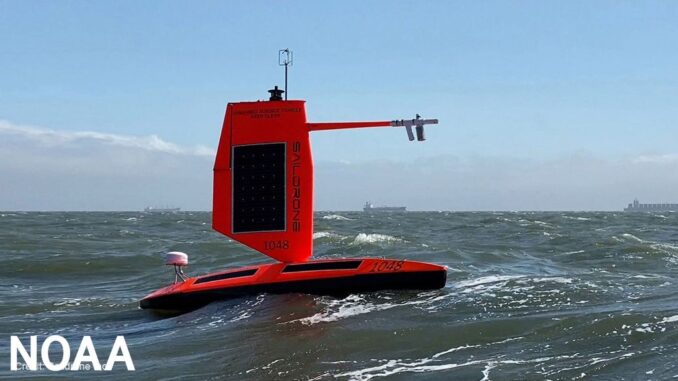
For the first time, an ocean drone captured video from inside a huge hurricane, gathering scientific data as the storm swept across the Atlantic Ocean on Sept. 30.
“The Saildrone Explorer SD 1045 was directed into the midst of Hurricane Sam, a Category 4 hurricane” that missed the East Coast as it churned up 50-foot waves with wind speeds exceeding 120 mph, according to the National Oceanic and Atmospheric Association.
The drone has a specially designed “hurricane wing” that enables it to operate in extreme winds in the open ocean, the association said.
It is “collecting real-time observations for numerical hurricane prediction models, which are expected to yield new insights into how large and destructive tropical cyclones grow and intensify,” the agency said.
Video released by NOAA and drone-maker Saildrone shows massive waves below dark gray sky, with a rolling motion due to high winds. This is “the first footage gathered by an uncrewed surface vehicle (USV) from inside a major hurricane barreling across the Atlantic Ocean,” Saildrone said on its website.

“Saildrone is going where no research vessel has ever ventured, sailing right into the eye of the hurricane, gathering data that will transform our understanding of these powerful storms,” said Richard Jenkins, the company’s founder and CEO.
The drones provide data directly to NOAA’s Pacific Marine Environmental Laboratory and Atlantic Oceanographic and Meteorological Laboratory, Saildrone’s partners in this mission, NOAA said.
“Using data collected by saildrones, we expect to improve forecast models that predict rapid intensification of hurricanes,” said Greg Foltz, a NOAA scientist. “Rapid intensification, when hurricane winds strengthen in a matter of hours, is a serious threat to coastal communities.
Data from the drones and other crewless systems NOAA is using will help to better predict the forces that drive hurricanes and to warn communities sooner, Foltz said.
“After conquering the Arctic and the Southern Ocean, hurricanes were the last frontier for Saildrone survivability,” Jenkins said. “We are proud to have engineered a vehicle capable of operating in the most extreme weather conditions on earth.”
The Atlantic hurricane season runs from June to November and September is generally the most active month. So far this season, there have been seven Atlantic hurricanes.
“Atmospheric and oceanic conditions remain conducive for an above-average hurricane season,” according to the annual mid-season update issued in Ausgust by NOAA’s Climate Prediction Center, a division of the National Weather Service.
When a storm’s maximum sustained winds reach 74 mph, NOAA says, it is called a hurricane. The Saffir-Simpson Hurricane Wind Scale is a 1 to 5 rating, based on a hurricane’s maximum sustained winds. The higher the category, the greater the hurricane’s potential for property damage, NOAA says.
Edited by Judith Isacoff and Matthew B. Hall
The post VIDEO: First Look: Drone Captures Video From Inside Hurricane appeared first on Zenger News.
